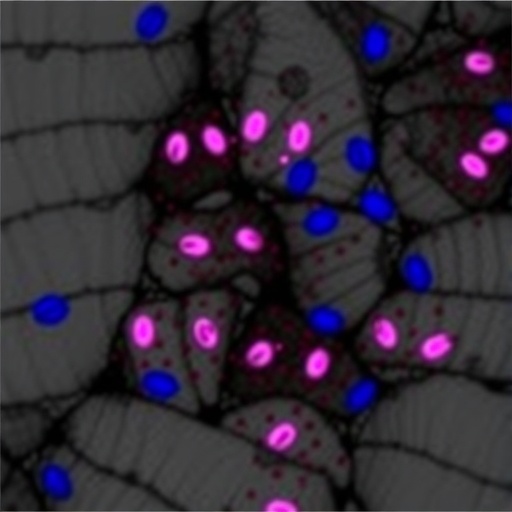In a groundbreaking study poised to redefine therapeutic approaches to liver fibrosis, researchers have unveiled the pivotal role of microRNA miR-125a-5p in regulating hepatic stellate cell (HSC) activation. The findings, recently published in Cell Death Discovery, reveal that overexpression of miR-125a-5p remarkably inhibits HSC activation and mitigates liver fibrosis by modulating the TGF-β/Smad2/3 signaling pathway and enhancing autophagic processes. This discovery opens a promising frontier in the treatment of chronic liver diseases, where fibrosis remains a significant clinical challenge and a major contributor to global morbidity and mortality.
Liver fibrosis, characterized by the excessive accumulation of extracellular matrix proteins, results from chronic liver injury and poses a threat of progression to cirrhosis and hepatocellular carcinoma. Central to this fibrogenic process are HSCs, which, upon activation, transform into proliferative myofibroblast-like cells that secrete fibrotic components. Despite advances in understanding fibrogenesis, targeted therapies remain elusive, largely due to the complex molecular interplay underlying HSC activation. This study’s focus on microRNAs, especially miR-125a-5p, sheds light on novel regulatory mechanisms that could be harnessed to curb fibrotic progression.
MicroRNAs serve as key post-transcriptional regulators of gene expression, influencing diverse cellular processes. miR-125a-5p, in particular, has been implicated in cellular differentiation, proliferation, and apoptosis across various tissues, but its specific function within the hepatic fibrotic milieu had remained unclear until now. Through meticulous experimentation, Zhang and colleagues demonstrated that boosting miR-125a-5p levels in activated HSCs exerts a suppressive effect on their fibrogenic activity, offering a new dimension to fibrotic disease modulation.
Delving into the mechanistic underpinnings, the study elucidated that miR-125a-5p negatively regulates the Transforming Growth Factor-beta (TGF-β) signaling axis, a master regulator of fibrogenesis. The TGF-β pathway exerts potent profibrotic effects via Smad2 and Smad3 phosphorylation, which facilitates extracellular matrix gene transcription. Overexpression of miR-125a-5p was observed to attenuate Smad2/3 activation, thereby reducing the fibrotic gene expression that drives HSC-mediated matrix deposition. This molecular intervention disrupts the pathological feedback loop sustaining fibrosis.
Simultaneously, the researchers uncovered that miR-125a-5p enhances autophagy, a cellular degradation pathway with a well-documented role in maintaining hepatic homeostasis and restraining fibrogenic activity. Autophagy enables cellular remodeling and clearance of damaged organelles, hence mitigating the stress signals that typically provoke HSC activation. By promoting autophagic flux, miR-125a-5p indirectly inhibits fibrotic progression, suggesting a dual mechanism by which it combats liver fibrosis – both through direct signaling modulation and cellular housekeeping functions.
Methodologically, the team employed state-of-the-art molecular biology tools, including gene overexpression and silencing techniques in cultured primary HSCs, alongside in vivo fibrosis mouse models. These robust approaches allowed for detailed dissection of miR-125a-5p’s functional impact at cellular and organismal levels. Histological analyses confirmed reduced collagen deposition and fibrotic markers in miR-125a-5p overexpressing subjects, correlating molecular findings with tangible disease amelioration.
One of the study’s striking revelations is the therapeutic potential of miR-125a-5p mimics as prospective antifibrotic agents. Unlike existing treatment modalities that primarily focus on symptom management or inhibiting single fibrogenic factors, miR-125a-5p-based therapies could simultaneously dampen profibrotic signaling and bolster protective autophagy pathways. This dual-target approach is anticipated to yield higher efficacy and better clinical outcomes in patients with advanced liver fibrosis and cirrhosis.
The implications of these findings extend beyond liver fibrosis alone. Given the conserved nature of TGF-β signaling and autophagy across fibrotic diseases in various organs, miR-125a-5p emerges as a candidate molecule with broader antifibrotic applications. The study encourages future exploration into miR-125a-5p’s role in pulmonary, renal, and cardiac fibrosis, potentially catalyzing a paradigm shift in how these pervasive diseases are tackled.
Moreover, the research underscores the importance of microRNAs as master controllers in pathological tissue remodeling. The intricate balance maintained by miR-125a-5p between cellular activation and autophagic clearance exemplifies the complex interplay central to tissue repair and fibrosis. Targeting such regulators could surpass the limitations of strategies aimed at downstream effectors, offering more comprehensive disease control.
The authors acknowledge that while the findings are compelling, translational barriers remain before miRNA-based therapeutics can enter clinical practice. Issues including delivery specificity, off-target effects, and long-term safety require thorough investigation. Nonetheless, advancing nanoparticle delivery systems and liver-targeted vectors provide an optimistic outlook for feasible clinical application of miR-125a-5p modulation.
Importantly, this study encourages revisiting the fibrogenic cascade with an integrated perspective, considering both signal transduction and cellular autophagy. This holistic understanding is crucial for designing multifaceted interventions that effectively resolve fibrosis rather than merely halt its progression. Zhang et al.’s work serves as a blueprint for such integrative efforts, combining molecular biology with pathophysiological insights.
Future research directions emerging from this work include deciphering the upstream stimuli regulating miR-125a-5p expression in hepatic tissue under fibrotic stress. Uncovering how environmental, metabolic, or inflammatory cues impact miR-125a-5p dynamics could reveal novel preventive strategies. Likewise, elucidating cross-talk between miR-125a-5p and other microRNAs or epigenetic modifiers could deepen comprehension of fibrosis plasticity.
In conclusion, the identification of miR-125a-5p as a crucial inhibitory factor of HSC activation and liver fibrosis through modulation of TGF-β/Smad2/3 signaling and autophagy opens new avenues for therapeutic innovation. This advancement heralds a promising era where precision molecular therapies could transform clinical management of chronic liver diseases. As the burden of fibrosis-associated conditions continues to rise worldwide, such pioneering research represents a beacon of hope for millions affected by debilitating and often fatal fibrotic disorders.
Subject of Research: MicroRNA regulation of hepatic stellate cell activation and liver fibrosis.
Article Title: Overexpression miR-125a-5p inhibits HSCs activation and alleviates liver fibrosis through TGF-β/Smad2/3 signaling pathway and autophagy.
Article References:
Zhang, C., Zhao, Y., Yan, H. et al. Overexpression miR-125a-5p inhibits HSCs activation and alleviates liver fibrosis through TGF-β/Smad2/3 signaling pathway and autophagy. Cell Death Discov. 11, 419 (2025). https://doi.org/10.1038/s41420-025-02694-4
Image Credits: AI Generated




